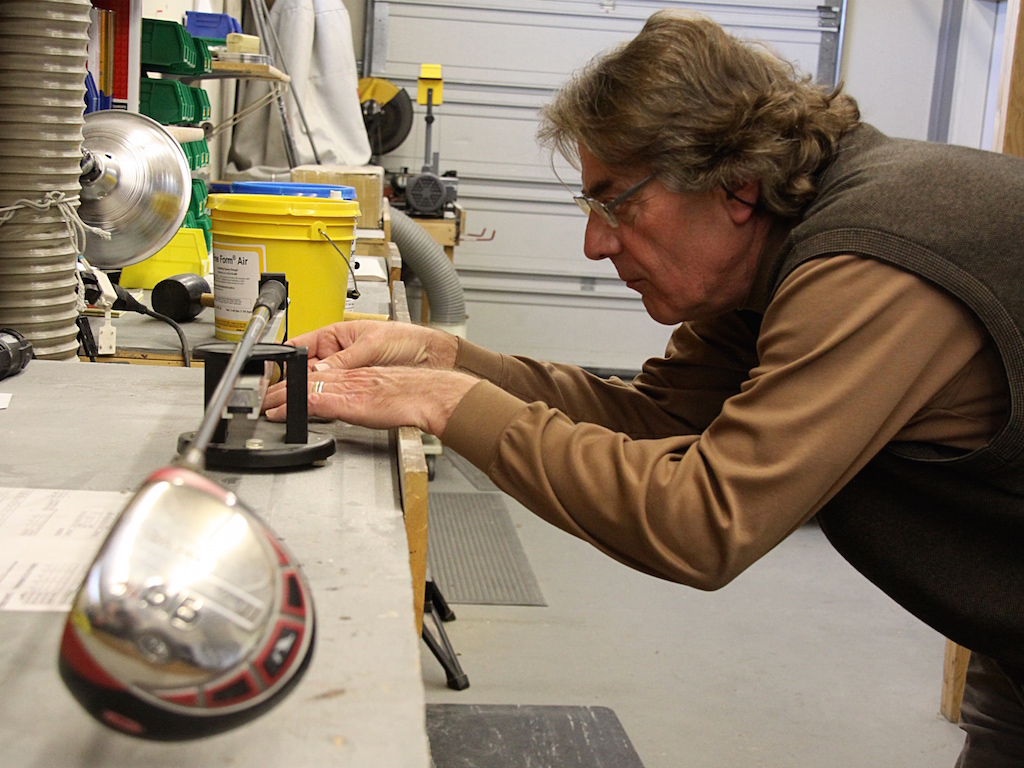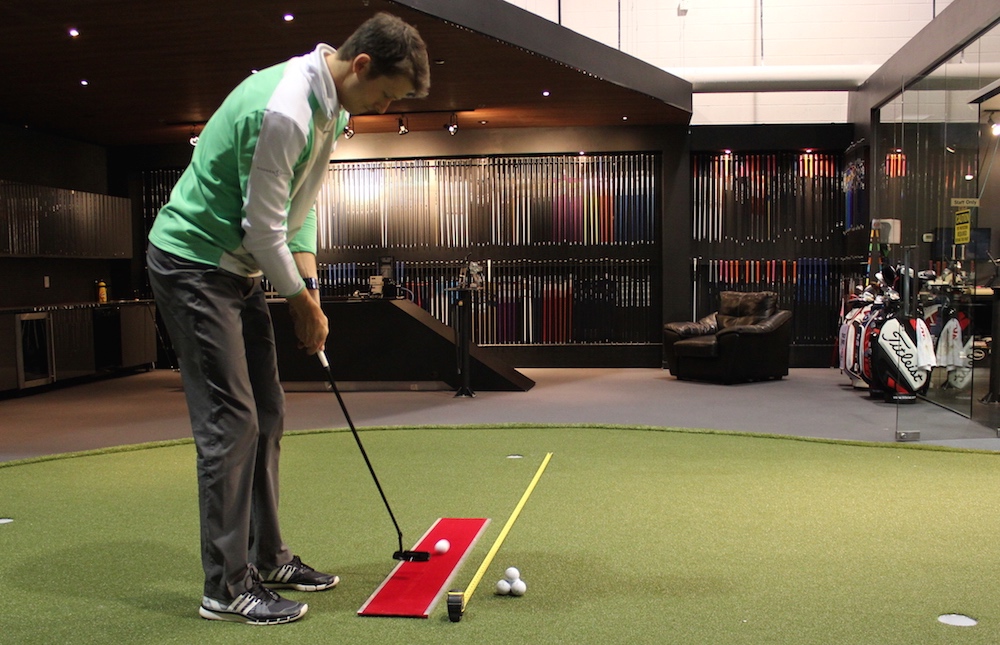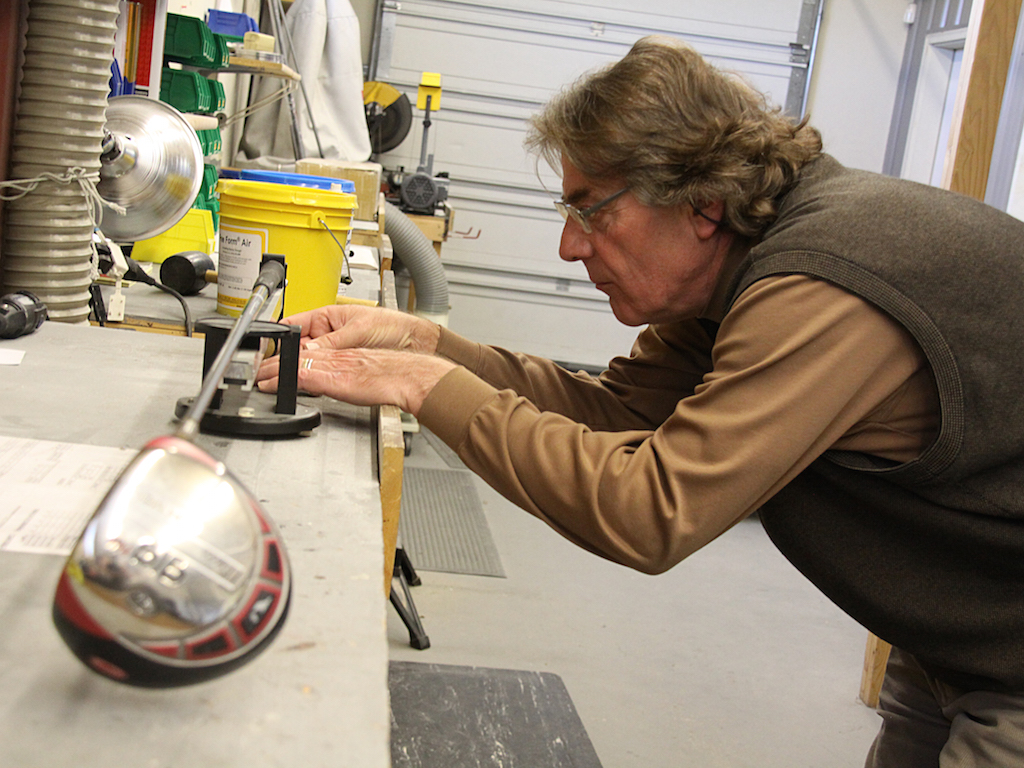Opinion & Analysis
Wishon: How to choose the right club head

Most golfers have to like the way their clubs look at address, so the psychological side of club head selection is very important. If golfers don’t like the way their new clubs look, the success of the overall fitting can be in jeopardy — regardless of how much improvement there is.
That’s why it’s important to fit golfers into club heads that have the potential to improve their performance (misdirection tendency, overall launch conditions/trajectory, etc.), but also keep the shape and style of the club heads a priority.
Clubhead shape/style elements to identify and match to the golfer’s preference typically involve height and blade length of the head, sole width, topline width, topline slope, leading edge radii, offset/face progression, sole radius/bounce/design, back design, and so on.
But while most of these aspects of the “look” of the head may be judged on an esoteric or qualitative manner, there are most definitely performance-based elements of the head design that have to be a very important part of the fitting of the clubhead. As such, there always has to be a balance in the clubfitter’s recommendation and the golfer’s acceptance of the head model.
That’s why when we teach clubhead model fitting, we begin the process by stressing the following guideline to clubfitters:
- Within all of the clubhead models that satisfy the golfer’s personal preferences for shape features, style, finish and cosmetics, recommend the ones that have the highest MOI and the best off-center hit performance.
- If the golfer also needs the utmost in distance and forgiveness for his ability and game-improvement goals, expand your recommendation to include the ones with the best face design for highest COR and best variable thickness construction.
When it comes to the pure performance side of clubhead fitting, the more experienced clubfitters will also keep these points in mind:
- For golfers with a definite need to reduce a slice or hook, recommend driver, wood and hybrid models that are available in different face angle options or those can be adjusted or bent to achieve the correct face angle to reduce the misdirection tendency.
Center of Gravity (CG) changes — either higher/lower or closer/further back from the face to achieve trajectory, shot shape, spin and shot height fitting goals — certainly can be attempted in the head recommendation. The effect of such CG changes may not bring about as much shot shape improvement as hoped, however, because they are so much affected by individual golfer characteristics of clubhead speed, consistency of the delivery of the head to impact and swing error tendencies.
In other words, don’t expect too much change in shot shape from a CG difference in a clubhead unless you are a more accomplished player with a higher-than-average clubhead speed and a proper impact position.
This does not mean that the clubfitter should ignore the benefits of a lower or more rearward-located CG for golfers with slower swings speed or those who need help keeping the ball in the air. Just don’t expect a big change in doing so.
While the final decision for the clubhead is always in the hands of the golfer, clubfitters should do their best to diplomatically explain the tangible benefits for using a clubhead model with a higher level of game improvement features than the golfer may think they need. Golf is a tough game to begin with and using a clubhead that cannot reduce the negative effects of swing errors is not the wisest decision if the goal is to play to the best of your ability.
What matters, what doesn’t
It usually takes BIG differences in head design technology to bring about small-to-medium differences in shot performance.
- A COR difference of 0.030 or more is significant for distance increase. A difference of 0.010 is not.
- An MOI difference of more than 1000 g-cm2 is significant for improvement on off-center hits. A difference of 600 g-cm2 or less is not.
- A vertical CG difference of more than 5 millimeters is significant for shot height and spin differences. One less than that is not for the vast majority of golfers.
- A face-to-back difference in CG of more than 8 millimeters can be significant for shot height and spin differences, but only for golfers with later-to-very-late releases. A face-to-back difference in CG of 5 millimeters or less is insignificant even for later release players.
- The more radius on the iron sole from face to back, the better the sole design is for EVERY golfer to very slightly help reduce the degree of “fatness” of a slightly fat shot. More face-to-back sole radius is also good for more consistent sole-to-turf interaction with Bermuda-type turf as well as for shots hit from the rough.
Related
- What length should your clubs be?
- What lofts should your clubs be?
- Face angle is crucial for a proper fitting
- The best way to fit lie angle
- How to choose the right club head design
- Tom Wishon’s keys to set makeup
- Getting the right size grip, time after time
- What shaft weight should you play?
- What swing weight should your clubs be?
- What shaft flex should I use?
This story is part of a 10-part series from Tom Wishon on professional club fitting.
Opinion & Analysis
The 2 primary challenges golf equipment companies face

As the editor-in-chief of this website and an observer of the GolfWRX forums and other online golf equipment discourse for over a decade, I’m pretty well attuned to the grunts and grumbles of a significant portion of the golf equipment purchasing spectrum. And before you accuse me of lording above all in some digital ivory tower, I’d like to offer that I worked at golf courses (public and private) for years prior to picking up my pen, so I’m well-versed in the non-degenerate golf equipment consumers out there. I touched (green)grass (retail)!
Complaints about the ills of and related to the OEMs usually follow some version of: Product cycles are too short for real innovation, tour equipment isn’t the same as retail (which is largely not true, by the way), too much is invested in marketing and not enough in R&D, top staffer X hasn’t even put the new driver in play, so it’s obviously not superior to the previous generation, prices are too high, and on and on.
Without digging into the merits of any of these claims, which I believe are mostly red herrings, I’d like to bring into view of our rangefinder what I believe to be the two primary difficulties golf equipment companies face.
One: As Terry Koehler, back when he was the CEO of Ben Hogan, told me at the time of the Ft Worth irons launch, if you can’t regularly hit the golf ball in a coin-sized area in the middle of the face, there’s not a ton that iron technology can do for you. Now, this is less true now with respect to irons than when he said it, and is less and less true by degrees as the clubs get larger (utilities, fairways, hybrids, drivers), but there remains a great deal of golf equipment truth in that statement. Think about it — which is to say, in TL;DR fashion, get lessons from a qualified instructor who will teach you about the fundamentals of repeatable impact and how the golf swing works, not just offer band-aid fixes. If you can’t repeatably deliver the golf club to the golf ball in something resembling the manner it was designed for, how can you expect to be getting the most out of the club — put another way, the maximum value from your investment?
Similarly, game improvement equipment can only improve your game if you game it. In other words, get fit for the clubs you ought to be playing rather than filling the bag with the ones you wish you could hit or used to be able to hit. Of course, don’t do this if you don’t care about performance and just want to hit a forged blade while playing off an 18 handicap. That’s absolutely fine. There were plenty of members in clubs back in the day playing Hogan Apex or Mizuno MP-32 irons who had no business doing so from a ballstriking standpoint, but they enjoyed their look, feel, and complementary qualities to their Gatsby hats and cashmere sweaters. Do what brings you a measure of joy in this maddening game.
Now, the second issue. This is not a plea for non-conforming equipment; rather, it is a statement of fact. USGA/R&A limits on every facet of golf equipment are detrimental to golf equipment manufacturers. Sure, you know this, but do you think about it as it applies to almost every element of equipment? A 500cc driver would be inherently more forgiving than a 460cc, as one with a COR measurement in excess of 0.83. 50-inch shafts. Box grooves. And on and on.
Would fewer regulations be objectively bad for the game? Would this erode its soul? Fortunately, that’s beside the point of this exercise, which is merely to point out the facts. The fact, in this case, is that equipment restrictions and regulations are the slaughterbench of an abundance of innovation in the golf equipment space. Is this for the best? Well, now I’ve asked the question twice and might as well give a partial response, I guess my answer to that would be, “It depends on what type of golf you’re playing and who you’re playing it with.”
For my part, I don’t mind embarrassing myself with vintage blades and persimmons chasing after the quasi-spiritual elevation of a well-struck shot, but that’s just me. Plenty of folks don’t give a damn if their grooves are conforming. Plenty of folks think the folks in Liberty Corner ought to add a prison to the museum for such offences. And those are just a few of the considerations for the amateur game — which doesn’t get inside the gallery ropes of the pro game…
Different strokes in the game of golf, in my humble opinion.
Anyway, I believe equipment company engineers are genuinely trying to build better equipment year over year. The marketing departments are trying to find ways to make this equipment appeal to the broadest segment of the golf market possible. All of this against (1) the backdrop of — at least for now — firm product cycles. And golfers who, with their ~15 average handicap (men), for the most part, are not striping the golf ball like Tiger in his prime and seem to have less and less time year over year to practice and improve. (2) Regulations that massively restrict what they’re able to do…
That’s the landscape as I see it and the real headwinds for golf equipment companies. No doubt, there’s more I haven’t considered, but I think the previous is a better — and better faith — point of departure when formulating any serious commentary on the golf equipment world than some of the more cynical and conspiratorial takes I hear.
Agree? Disagree? Think I’m worthy of an Adam Hadwin-esque security guard tackle? Let me know in the comments.
@golfoncbs The infamous Adam Hadwin tackle ? #golf #fyp #canada #pgatour #adamhadwin ? Ghibli-style nostalgic waltz – MaSssuguMusic
Podcasts
Fore Love of Golf: Introducing a new club concept

Episode #16 brings us Cliff McKinney. Cliff is the founder of Old Charlie Golf Club, a new club, and concept, to be built in the Florida panhandle. The model is quite interesting and aims to make great, private golf more affordable. We hope you enjoy the show!
Opinion & Analysis
On Scottie Scheffler wondering ‘What’s the point of winning?’

Last week, I came across a reel from BBC Sport on Instagram featuring Scottie Scheffler speaking to the media ahead of The Open at Royal Portrush. In it, he shared that he often wonders what the point is of wanting to win tournaments so badly — especially when he knows, deep down, that it doesn’t lead to a truly fulfilling life.
View this post on Instagram
“Is it great to be able to win tournaments and to accomplish the things I have in the game of golf? Yeah, it brings tears to my eyes just to think about it because I’ve literally worked my entire life to be good at this sport,” Scheffler said. “To have that kind of sense of accomplishment, I think, is a pretty cool feeling. To get to live out your dreams is very special, but at the end of the day, I’m not out here to inspire the next generation of golfers. I’m not out here to inspire someone to be the best player in the world, because what’s the point?”
Ironically — or perhaps perfectly — he went on to win the claret jug.
That question — what’s the point of winning? — cuts straight to the heart of the human journey.
As someone who’s spent over two decades in the trenches of professional golf, and in deep study of the mental, emotional, and spiritual dimensions of the game, I see Scottie’s inner conflict as a sign of soul evolution in motion.
I came to golf late. I wasn’t a junior standout or college All-American. At 27, I left a steady corporate job to see if I could be on the PGA Tour starting as a 14-handicap, average-length hitter. Over the years, my journey has been defined less by trophies and more by the relentless effort to navigate the deeply inequitable and gated system of professional golf — an effort that ultimately turned inward and helped me evolve as both a golfer and a person.
One perspective that helped me make sense of this inner dissonance around competition and our culture’s tendency to overvalue winning is the idea of soul evolution.
The University of Virginia’s Division of Perceptual Studies has done extensive research on reincarnation, and Netflix’s Surviving Death (Episode 6) explores the topic, too. Whether you take it literally or metaphorically, the idea that we’re on a long arc of growth — from beginner to sage elder — offers a profound perspective.
If you accept the premise literally, then terms like “young soul” and “old soul” start to hold meaning. However, even if we set the word “soul” aside, it’s easy to see that different levels of life experience produce different worldviews.
Newer souls — or people in earlier stages of their development — may be curious and kind but still lack discernment or depth. There is a naivety, and they don’t yet question as deeply, tending to see things in black and white, partly because certainty feels safer than confronting the unknown.
As we gain more experience, we begin to experiment. We test limits. We chase extreme external goals — sometimes at the expense of health, relationships, or inner peace — still operating from hunger, ambition, and the fragility of the ego.
It’s a necessary stage, but often a turbulent and unfulfilling one.
David Duval fell off the map after reaching World No. 1. Bubba Watson had his own “Is this it?” moment with his caddie, Ted Scott, after winning the Masters.
In Aaron Rodgers: Enigma, reflecting on his 2011 Super Bowl win, Rodgers said:
“Now I’ve accomplished the only thing that I really, really wanted to do in my life. Now what? I was like, ‘Did I aim at the wrong thing? Did I spend too much time thinking about stuff that ultimately doesn’t give you true happiness?’”
Jim Carrey once said, “I think everybody should get rich and famous and do everything they ever dreamed of so they can see that it’s not the answer.”
Eventually, though, something shifts.
We begin to see in shades of gray. Winning, dominating, accumulating—these pursuits lose their shine. The rewards feel more fleeting. Living in a constant state of fight-or-flight makes us feel alive, yes, but not happy and joyful.
Compassion begins to replace ambition. Love, presence, and gratitude become more fulfilling than status, profits, or trophies. We crave balance over burnout. Collaboration over competition. Meaning over metrics.
Interestingly, if we zoom out, we can apply this same model to nations and cultures. Countries, like people, have a collective “soul stage” made up of the individuals within them.
Take the United States, for example. I’d place it as a mid-level soul: highly competitive and deeply driven, but still learning emotional maturity. Still uncomfortable with nuance. Still believing that more is always better. Despite its global wins, the U.S. currently ranks just 23rd in happiness (as of 2025). You might liken it to a gifted teenager—bold, eager, and ambitious, but angsty and still figuring out how to live well and in balance. As much as a parent wants to protect their child, sometimes the child has to make their own mistakes to truly grow.
So when Scottie Scheffler wonders what the point of winning is, I don’t see someone losing strength.
I see someone evolving.
He’s beginning to look beyond the leaderboard. Beyond metrics of success that carry a lower vibration. And yet, in a poetic twist, Scheffler did go on to win The Open. But that only reinforces the point: even at the pinnacle, the question remains. And if more of us in the golf and sports world — and in U.S. culture at large — started asking similar questions, we might discover that the more meaningful trophy isn’t about accumulating or beating others at all costs.
It’s about awakening and evolving to something more than winning could ever promise.


















dime bag
Feb 4, 2015 at 8:43 pm
When my 4 year gets crabby we put him in a special chair called the “pouty place”. Does Keith need to sit in the “pouty place” for a while until he can act like a big guy?
Keith
Feb 4, 2015 at 9:11 pm
Yes, I think I do…but I just had a Snickers bar so I think I am better now.
JOEL GOODMAN
Feb 4, 2015 at 8:32 pm
why the negativity from these guys? If you don’t like it , go away. Tom Wishon has forgotten more about golf clubs than 99% of people will ever learn. He is pure genius and is worth listening to and reading his views. WRX is a superb vehicle for information not available through the “how to cure your slice”media. I love it and think Tom Wishon is terrific. Disclosure-I have purchased and built clubs using Wishon components and am using one of his drivers. I also play Mizuno MP68 irons, and wedges. I live in south Florida, age 79 index 7.7 and play 5 days every week, 52 weeks a year–JEALOUS?????
chris
Feb 4, 2015 at 8:56 pm
I could agree more, being new to this site I have found Tom’s articles to be the most informative that I have read here. Keep up the good work Tom.
Keith
Feb 4, 2015 at 9:13 pm
Yes, I am jealous…and…Yes, I agree Mr. Wishon is a genius and makes a great product.
Benny
Feb 4, 2015 at 7:12 pm
Awesome stuff Tom, makes complete sense. I have a couple friends of mine who bought Wishon that were properly fitted and while very high handicappers their games have really improved and feel it’s from proper fitting. Most amateur golfers are very steep in their swings. They stand very up right and close to the ball so the angle is steep and adding the radius helps them. Add this to your adjustable hozels on your woods/drivers and you really have the best fitted clubs money can buy. Never mind priced way below most manufactures. You just cannot beat it and I am extremely excited to be getting my woods from one of your builders this spring.
Please keep this info coming because even the negative talk on here is helping get your points across. Thanks Tom, thanks WRX!
Bob
Feb 4, 2015 at 12:22 pm
Is he saying the wider the sole the better it is for all players.
Shallowface
Feb 4, 2015 at 3:50 pm
You can certainly have face to back radius or camber in a narrow sole, so I don’t think Tom was saying that the sole has to be wide.
Tom Wishon
Feb 4, 2015 at 5:41 pm
shallowface
Not sole width – I was talking about the sole radius in the direction from front to back across the sole being good for all players. Add a rounding of the leading edge from sole around to face and that is better for everyone too. Such sole designs stand up better for those with more downward angle of attack into the ball, and they can help slightly for shots from the rough because the greater front to back sole radius offers less surface contact to the grass for a little less chance of the sole hanging up in the rough.
myron miller
Feb 4, 2015 at 12:08 pm
Tom, I notice you don’t talk about CT time for any of the clubs, especially the driver as being important. Is it because you don’t feel its a factor or what?
I’m asking because at least one driver manufacturer tries to emphasis its higher CT time as being critical to improving distance. Personally I don’t see how CT time on the face makes that much difference especially considering all the differences in golf ball hardness.
Tom Wishon
Feb 4, 2015 at 6:01 pm
Myron
In the article I did say this. . .
Within all of the clubhead models that satisfy the golfer’s personal preferences for shape features, style, finish and cosmetics, recommend the ones that have the highest MOI and the best off-center hit performance.
If the golfer also needs the utmost in distance and forgiveness for his ability and game-improvement goals, expand your recommendation to include the ones with the best face design for highest COR and best variable thickness construction.
Thus the comment about highest COR as a part of a clubhead recommendation for a golfer who needs/wants the utmost in distance. CT/COR is a non issue with drivers and has been for a long time because virtually every titanium driver made since the late 90s has been maximized for COR to be as close to the limit as the company’s production of the head will allow under normal +/- tolerances. Of course if the golfer wants to eek out the absolute most in driver COR, he can hit several models and look for the one that records a smash factor of 1.49-1.50 which is the max possible for an 0.830 COR/257 CT face measurement.
CT is just a different form of test to enable the USGA to assess the ability of the face to flex inward at impact more quickly than it takes to run an actual air cannon COR test. With driver heads, CT is correlatable to an actual COR test measurement. It is not in irons. So the reason CT is pertinent to distance is because the more you get the face to flex at impact without deforming, the less energy is lost in the collision between the face and the ball. That right there is the basic science behind COR. From this comes the higher ball speed in relation to the clubhead speed – aka smash factor. So if you have a driver with a CT of say, 260 and one at 240, without question the ball speed in relation to clubhead speed for the 260CT will be higher than the one at 240, and from this will come more distance if the loft and everything else is fit correctly to the golfer.
Let me explain how this works with respect to different ball compression types and ball construction. With a low COR head, in the collision between the face and the ball, 80% of the energy loss from the impact comes from the compression of the ball against the face. Squash the ball more, you lose more energy. 20% comes from the face flexing inward only a tiny bit as a low COR head. If you allow the face to flex inward more, what you do is you greatly reduce the amount that the ball squashes against the face. So the ball’s energy loss is much less than the increase in energy loss from the face flexing inward a little more.
To grasp this, realize that the face of an 0.830 COR driver flexes inward just short of 1/16″ at impact. The face of a low COR (0.780) driver flexes inward a little less than 1/32″. So just for an additional 1/32″ of face flexing, the energy transfer is much greater due to a lot less squashing of the ball so the ball speed can increase quite a bit in relation to the clubhead speed.
With a soft ball like a Noodle, with a low COR head, that ball at 100mph clubhead speed will squash around 30% of its diameter. Change to a high COR head and that same ball now squashes around 20% of its diameter, thus reducing the energy loss and increasing the energy transfer to the shot to get more ball speed. With a hard solid ball, with a low COR head, that ball at 100mph clubhead speed will squash around 20% of its diameter. Change to a high COR head and that same ball now squashes around 12% of its diameter, thus reducing the energy loss and increasing the energy transfer to the shot to get more ball speed.
So the high COR face design works to increase ball speed and distance no matter what the ball construction.
chris
Feb 4, 2015 at 8:33 pm
That was a very informative reply for those of us who don’t have a strong grasp of what happens to the and the club face at impact.
Keith
Feb 4, 2015 at 11:38 am
I am slightly confused by these articles…are these just long advertorials as a point of differentiation from other manufacturers? It seems like a conflict of interest to have a manufacturer of golf clubs writing articles for your site without slugging this as an advertisement…especially if you drive to his site at the bottom of the page.
You may not be explicitly selling his product, by you are advertising his process and have alluded to others not being as thorough in previous articles. Being part of the Conde Nast family you would think your editors would know this is not okay….but alas you will probably delete this comment and continue as usual.
Zak Kozuchowski
Feb 4, 2015 at 11:46 am
Keith,
First off, GolfWRX is independently owned and operated — not part of the Conde Nast family or affiliated with Conde Nast in any way.
Secondly, this is not an advertisement. Tom Wishon is a GolfWRX Contributor and part of our Featured Writers program. We’re working with him on this series because we think he can help our readers better understand club fitting and their club fitting needs. He does not pay us to publish this stories.
Last, we only delete comments that are wildly off topic, use inappropriate language or personally attack or authors. If you’ve had a comment deleted, that’s why.
– Zak Kozuchowski
GolfWRX Managing Editor
Shallowface
Feb 4, 2015 at 12:05 pm
I consider myself to be highly sensitive to the things Keith mentions, and I consider Tom’s articles to be just fine. Anything that helps us be more educated consumers is most welcome, and from a lot of what I read here is sorely needed.
Looking forward to the rest of the series!
Keith
Feb 4, 2015 at 3:18 pm
I appreciate the response, but respectfully disagree with what you have said here. This is absolutely an advertisement and your readers should know that. You are driving to his company site in which his whole sales pitch is custom fitting. I find it hard to believe that site traffic and conversion (lead) is not being tracked on wishongolf.com from GolfWrx.com.
I don’t have an issue with the article and agree it may be helpful…but it is without a doubt advertising.
Also, does your partnership with Golf Digest for content production and distribution not count as being affiliated with Conde Nast? Perhaps we are forgetting about this comment
“Joining forces with an established and authoritative brand such as the Golf Digest Properties will resonate with the passionate community we’ve cultivated with GolfWrx,” said Richard Audi, president of GolfWrx. “We welcome the contributions of its editors and look forward to creating innovative new offerings for advertisers in the conversational web.”
Zak Kozuchowski
Feb 4, 2015 at 3:38 pm
Keith,
GolfWRX is no longer associated with Golf Digest, and has and always has been independently owned and operated.
We have and will continue to have contributors write for us about things we consider to be valuable to our readers.
Let’s not muck up this comments section with unrelated comments any further.
Keith
Feb 4, 2015 at 3:43 pm
Zak…come on..really…no longer affiliated? I will let it go because I am a fan of the site, that is fine.
Steven
Feb 4, 2015 at 2:41 pm
Where the f@#$ did you get the idea WRX was part of Conde Nast?
And who the f@#$ still uses the term ‘but alas’?
Since you don’t know, WRX was started and still run by a few guys in Detroit, with a handful of very involved contributors across the country.
https://www.youtube.com/watch?v=lBIt-p5ruBM
Keith
Feb 4, 2015 at 3:46 pm
Hahahaha thank you for sharing that link, one of my favorite episodes and I 100% agree. You seem like a real stand up guy Steven!